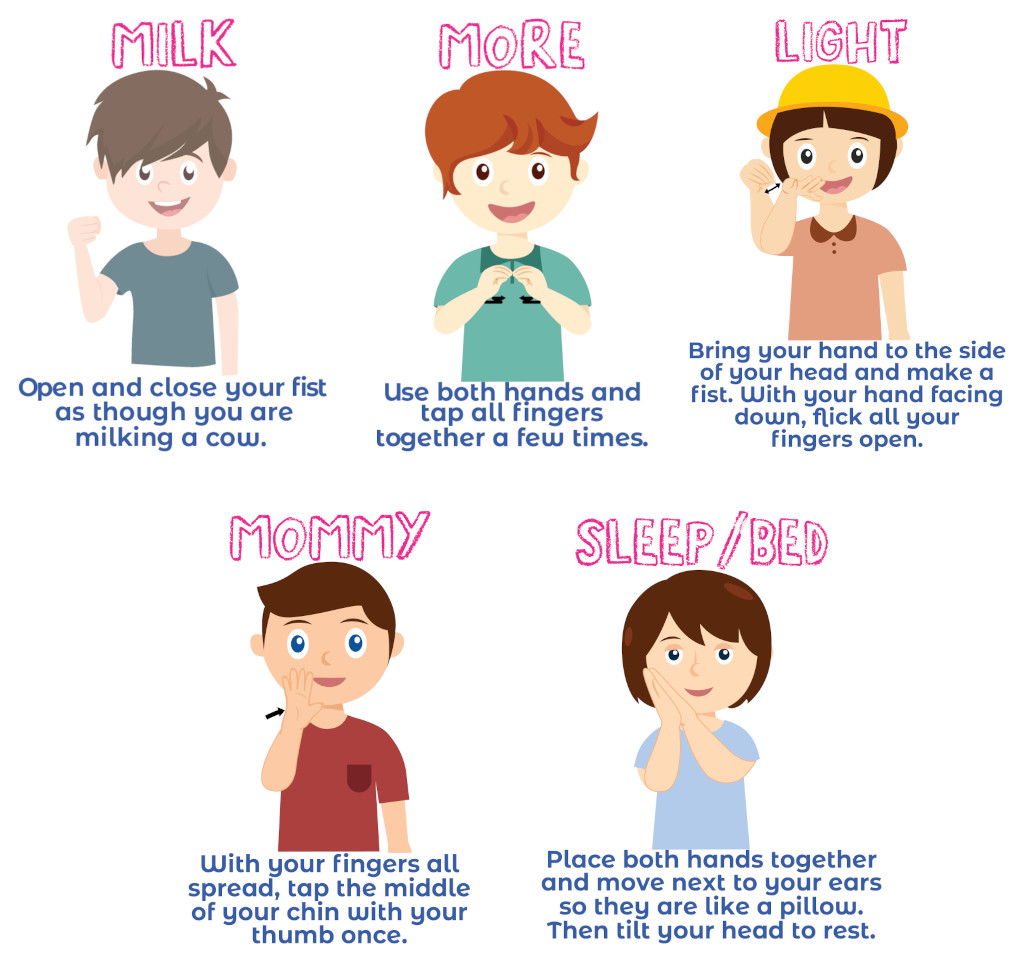SingaporeMotherhood | Baby & Toddler
October 2021
Baby Sign Language: Why Every Parent Should Learn It and How to Start

Just imagine if your baby could tell you they are hungry, thirsty, tired, or what they are thinking…. All before they can even speak. Cue baby sign language, which makes all this possible. Baby sign language is a communication tool for both parents and pre-verbal babies and toddlers, using specific hand shapes and gestures to express needs, desires, or objects.
But My Baby Can Hear!
You don’t need to be hearing impaired, or have a baby with hearing issues, to learn sign language. Signing reduces the guesswork during the phase before your baby learns to understand your words and speak to you. In the meantime, parents can develop a better understanding of their baby’s personality, needs, and wants. In other words, baby sign language makes parenting easier!
(See also: Hearing Loss In Babies and Children: Why it Happens, What You Can Do)
Signing even boosts confidence and self-esteem as it enables two-way communication from a young age. This means it allows babies to lead the conversation too. Using baby sign language helps babies feel understood, resulting in less tears, tantrums, and frustration, which means a calmer household.
One misconception about baby sign language is that it slows down the acquisition of speech. In fact, research by psychologists Dr Linda Acredolo and Dr Susan Goodwyn, authors of the book “Baby Signs: How to Talk with Your Baby Before Your Baby Can Talk”, found that hearing babies who learn to sign actually learn to speak earlier than non-signing babies, and have larger vocabularies.

Baby Sign Language Gaining Popularity
Over the past few years, baby sign language has grown in popularity among Singaporean families. Many Singaporean parents who have used baby sign language say it is a game changer.
One of these is Joey Tay, owner of La Petite Pochette, who used baby sign language with her daughter Gabby. She says, “Using sign language was really useful for my baby. My girl was able to sign to me things that she could see or wanted to tell me. Saved us from a lot of temper throwing and crankiness.”
Anabel Chew, co-founder of WeBarre and mum of one-year-old Ari agrees. “We are really enjoying communicating with Ari and giving her an outlet to find her own voice and be able to express it,” she says. “I had long heard about the wonderful benefits of signing with babies, and while sign language seems like quite an ‘easy’ thing to do, the online course we completed gave us super useful tips to really set us up for success. We saw results in as quick as one week!”
(See also: 8 Ways to Boost your Baby’s Speech and Language Skills)
Anabel was referring to Chatterbub Signing School, a new offering that recently launched a pre-recorded, online course to make learning baby sign language convenient and affordable. Chatterbub’s owner, Melanie Horner, has lived in Singapore for almost a decade and pre-Covid was teaching playgroup style classes islandwide. She shares some tips and resources on how to get started with baby sign language.
Which Signs Should We Start with?
This is one of the most common questions from parents who are starting to explore baby sign language. When starting out, it is recommended to introduce three to five words at a time.
The best starter signs are those that will really motivate your baby to communicate, such as “milk”, “more”, and “light”. “Mummy” and “sleep” or “bed” are also popular. Here’s how to sign them:

Once you have the basics, keep going and try more words. Watch these brilliant tots-in-action showing us the way:
So How Do We Begin Signing?
As with any new skill, baby sign language does require some effort and a lot of repetition. The key is to stay patient and make signing fun and part of your routine.
It’s important to remember that each baby is different, and they learn at their own pace. Typically, babies won’t sign back before they’re seven to eight months old. But this doesn’t mean you can’t start signing to them from day one. Younger babies may take a week or many months before they sign back, while toddlers have the ability to learn to sign quickly, and may even sign back within a day.
(See also: Childhood Development: Is My Child Meeting Milestones at the Right Time?)
Here are some sure-fire tips to ensure your baby is signing back in no time at all!
- Always sign and say the word at the same time. Try using the “Sign It, Say It, and then Hand It Over” method. “It” refers to any item that is of interest to your baby. For example, at mealtimes, ask your baby if they would like a drink while signing it. Give them time to respond before handing them a drink.
- Use facial expressions and voice variation or even sounds to capture your baby’s attention.
- Wait for a response. Like you would in a conversation, make sure you give your baby time to respond.
- Always sign in context — otherwise it won’t make much sense.
- Use signs to help your baby understand their daily routines. It provides them with a cue on what’s coming up next, and helps make them part of the transition. For example, use signs and explain to your baby that playtime is over, and it is now bath time.
Useful Baby Sign Language Resources
These days, there are plenty of resources available for families wanting to learn more about baby sign language. So whether you prefer a book, course, or learning from songs, your choice may be influenced by what type of learning style works best for you, along with accessibility to and immediacy of materials.

We’ve compiled a round-up of the best methods available to families in Singapore:
Online course – The Chatterbub Signing School course includes a five-part strategy to ensure success, and more than 60 signs for functional words. It comes along with an e-book, posters, and a baby sensory activity guide. The online course is self-paced, so you can complete it in one sitting or whenever convenient, such as during nap times or commuting on-the-go.
Psst! Chatterbub Signing School is giving 10 SingaporeMotherhood readers full access to its online course for FREE! Read on to find out how to take part in our giveaway…
In-person classes – Baby Signs Singapore runs playgroup-style classes that parents attend with their baby. During the classes, an instructor will teach you signs through games and music. Courses typically run for four to six weeks.
(See also: 13 Places to Bring Bub for Brain-boosting Fun and Creative Baby Activities)
Books and e-books – Consider if you are looking for a book for adults to learn the signs and then teach your baby. Or perhaps you prefer a picture book featuring signs that you can read to and enjoy with your baby.
- For adults, we recommend: “Baby Sign Language Made Easy: 101 Signs to Start Communicating with Your Child Now” by Lane Rebelo. This book includes more than 100 practical signs, along with what, where, when, and how of baby sign language.
- For babies, we recommend: “Baby Signs: A Baby-Sized Introduction to Speaking with Sign Language” by Joy Allen. This board book features illustrations of a baby signing the most common signs such as milk, more, and mummy, which you can read over and over again with your baby.
YouTube videos – While there are plenty of resources for baby sign language on YouTube, one downside to be mindful of is learning a few signs does not guarantee a successful signing experience. We recommend searching for content by Patty Shukla, as well as Rachel Coleman from Signing Time, which include colourful videos with fun songs including signs from American Sign Language.
:: GIVEAWAY! ::
We have 10 Chatterbub Signing School online courses each worth US$47 (about S$64) to give away. You get full access to the course, indefinitely!
How to win:
1. Like and share this article on Facebook with the hashtag #SMxChatterbub
2. Tag 3 mummy/daddy friends who would like to learn baby sign language too
3. Like Chatterbub’s Facebook page and Instagram account
4. Sit back and relax; we’ll let you know if you’re a winner!
Closing date: 11.59pm, 18 October 2021
All content from this article, including images, cannot be reproduced without credits or written permission from SingaporeMotherhood.
Follow us on Facebook, Instagram, and Telegram for the latest article and promotion updates.





